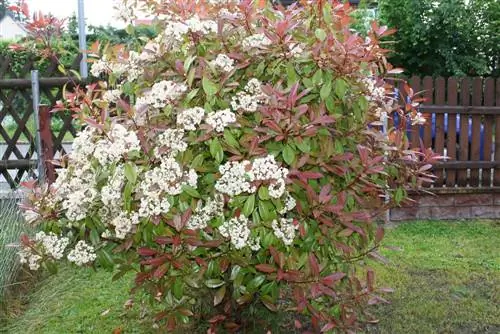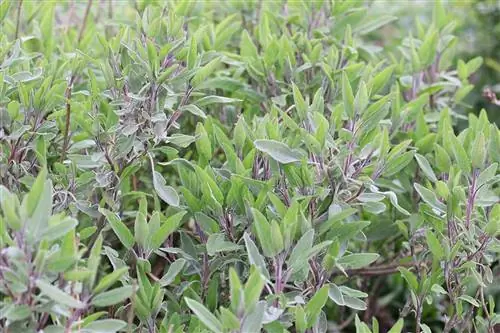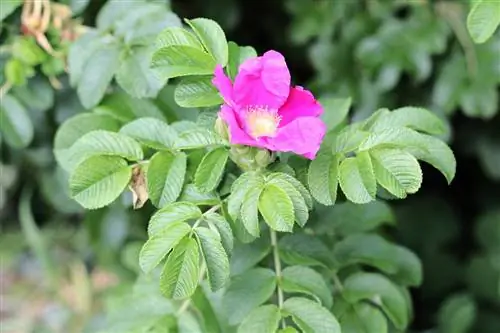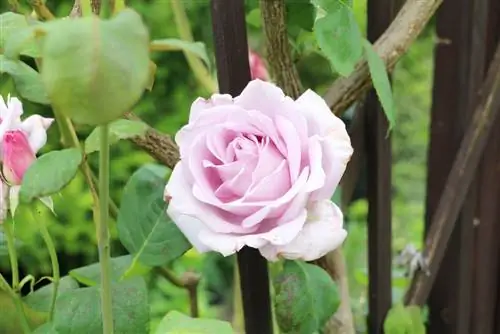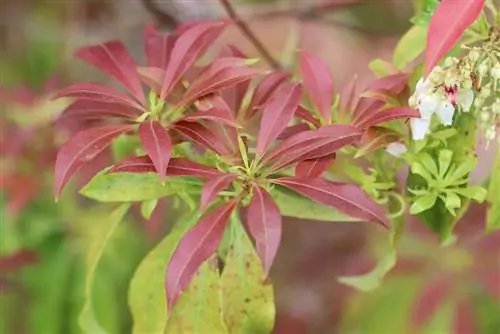- Author admin [email protected].
- Public 2023-12-17 03:39.
- Last modified 2025-06-01 06:48.
All species of the magnificent genus of loquats are characterized by a good-natured tolerance to pruning. In principle, you can cut back the ornamental shrub at any time. However, the attractive tree from the rose family should not be cut under the influence of summer heat and drought or winter frost. Nevertheless, there is a perfect time for the different cut variants. The following overview shows when you should optimally cut back a Photinia.
When is the best time?
- Shape and care pruning: immediately after the flowering period in June/July
- Corrective pruning on hedges: between the end of August and the beginning of September
- Lighting cut: in late winter, ideally in January/February
- Rejuvenation cut: between October 1st and February 28th
- Do not cut in case of frost, extreme drought or summer heat
The protection of breeding birds is of great importance in tree care. This is expressed in the Federal Nature Conservation Act. Since 2010, there has been a clearly defined time frame for pruning shrubs and hedges that every gardener should be familiar with. Radical rejuvenation cuts are prohibited between March 1st and September 30th. Only light pruning may be carried out during the breeding season, provided that there are no bird nests in the bush or crown.
General cutting rules - tips for exemplary cutting
A loquat only shows off its decorative strengths if it is professionally cut at the right time. The furious triad of colorful leaf shoots, distinctive flower spikes and autumnal fruit decorations depends on a planned cut. The following pruning rules apply in principle, regardless of whether you cultivate loquats as a solitary plant, hedge or standard tree:
- The stronger the pruning, the stronger the resulting shoots
- Best starting point for the scissors: 3-5 mm above an outward-facing bud
- Slightly diagonal cut allows rain and irrigation water to drain better
- On the standard trunk: Thinning cut on a string without stub remains
- Saw off thick branches in stages
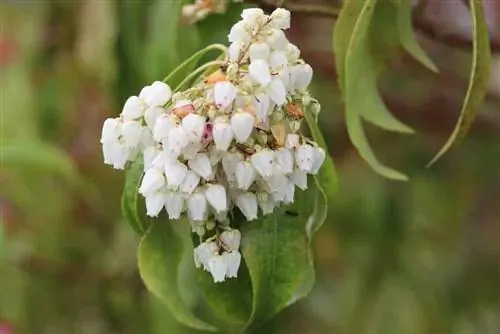
The last two pruning rules require the following, more detailed explanations: If the branches are too close in the crown of a tree, some specimens have to give way. In this case, position the scissors in such a way that the branch ring is not injured. This is the bulging transition from the branch to be removed to the parent branch. If it is a strong branch with a diameter of more than 5 cm, proceed in stages. In the first step, saw the shoot from the underside to the middle. This cut is made about 30 cm away from the branch. Then place the saw 5 to 10 cm offset from the top and saw until the branch breaks off. Now you can cut off the remaining stub on Astring without having to worry about damaging the trunk bark.
Tip:
Behind the distinctive appearance of a loquat hides a defensive ornamental shrub. A Photinia uses sharp thorns to keep uninvited guests at bay and also leaves painful scratches on the skin of a caring gardener's hand. Therefore, wear thorn-proof gloves with long cuffs for care and cutting work.
Cutting solitary - instructions for topiary
In individual cases, regular pruning is not mandatory. In fact, in the first few years you can enjoy the brilliant color spectacle of red shoots, white flowers and bright berries of your loquat without any worries. With an average annual growth of 40 cm and loose growth, the compact stature is lost over time. Furthermore, the eye-catching, red shoots become noticeably weaker from year to year. If this detrimental development becomes apparent, bring the ornamental shrub back into shape by pruning it back. This is how it works:
- In early summer, cut back the shrub by a third overall
- Alternatively, just shorten branches that grow out of the shape
- Ideally intersect the shoots in a suggested dome shape for optimized light supply
- In late winter, thin out all dead, crossing branches and branches that are too close together
The more regularly you cut a loquat after flowering, the more lush the colorful shoots will grow next spring. Unfortunately, this cut also has a downside. If all the withered flowers fall victim to the scissors, you will look in vain for the red berry decorations in autumn.
Did you know that the premium variety 'Red Robin' is now also available for small gardens and containers?
The little brother 'Little Red Robin' remains at a height of 100 to 150 cm. This gives the individual shoots more stability, so that the small shrub naturally grows densely. Cultivated as a solitary plant, pruning care is therefore limited to annual thinning.
Cutting the cotoneaster hedge - you should pay attention to this
Their shiny green leaves catch light all year round. This fact should be taken into account when cutting a loquat hedge. The shrubs only thrive when planted in rows, dense and compact from base to tip, if the sun can reach all areas. Please pay attention to the following step-by-step instructions for exemplary hedge trimming:
- In early summer, cut the hedge back to the desired growth form
- Ideally cut into a trapezoid shape with a wide base and narrow top
- If necessary, carry out a corrective cut in late summer
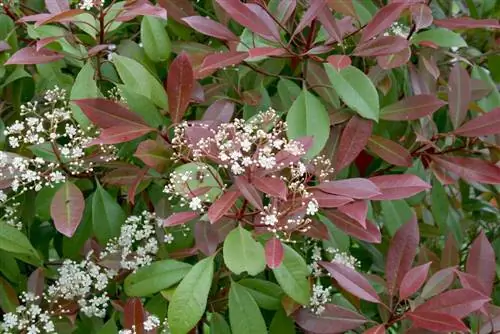
The robust pruning tolerance of loquats also allows further topiary pruning until shortly before the beginning of autumn. Pruning at a later date affects the perennial's winter hardiness. The following time window is too short for the fresh shoots to ripen in time before the start of winter. On such a weakened shrub, frost damage is inevitable with the risk of total failure.
High trunk - instructions for crown pruning
The loquat is in great demand as a standard tree. When its lush crown towers over a straight trunk and displays its colorful play of colors in spring, the master gardener has done excellent preparatory work with the training pruning. To ensure that the floral magic repeats itself every year, you cannot avoid regular crown pruning. The aim of the pruning measures is a slender, stable trunk, no branches at eye level and a spherical, loose, bushy crown. This is how the plan works:
- Starting with the end of the flowering period, cut back branches that are too long
- Carry out further corrective cuts at intervals of 4 to 6 weeks
- The last time I did a light topiary was at the beginning of September
- Thoroughly thin out the crown in January or February
In addition, remove all side shoots that sprout below the crown. If your loquat standard is a graft, blind shoots can also grow from the wild rootstock. Please remove these continuously throughout the entire growing season because they compete with the noble branches of the crown for nutrients and water. Ideally, you should tear off wild shoots with a strong tug in order to completely remove all parts of the tissue.
Did you know that you can train a loquat to become a standard tree yourself?
Select the strongest central shoot on the young bush and tie it to a stick. Cut off all competing shoots at the base and remove unnecessary side shoots. Guide the central shoot to the desired trunk height. There you cut the tip 4 leaves above the planned crown base. The branching to the crown then begins.
Cotoneaster with frost damage - what to do?
In the silent fight against freezing frost, the young shoots are sometimes affected. The Asian gem has not learned to withstand temperatures below -10 degrees Celsius without winter protection. Frost damage is therefore not uncommon in wind-exposed locations. Typical symptoms are frozen, limp shoot tips and withered leaves.
The weather signals when you can regulate the damage with optimal success. The best time has come when there is no longer any risk of severe frost below -10 degrees Celsius. Cut all frozen shoots back to he althy wood. Please make sure that there is a he althy bud or branch 5 to 10 mm below the cut point.
Tip:
In the pot, your loquat has little chance of overwintering outdoors undamaged. If there is a lot of space in the winter quarters, there is nothing to be said against cutting it back before clearing it away. Shorten the branches by a third and thin out dead wood and unfavorable shoots.
Cotoneaster sheds leaves - this is how a rejuvenating cut solves the problem
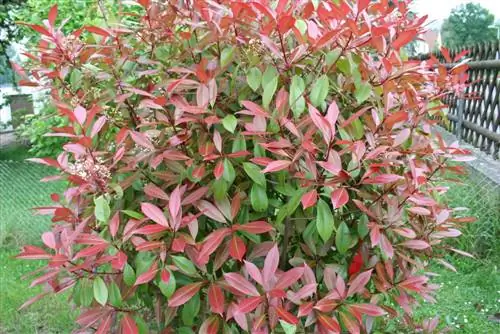
Cotoneasters react to location problems and improper watering by falling leaves. As a result of drought or waterlogging, the plant sees its existence threatened and sheds its leaves to protect itself. There is now an immediate need for action to save the noble ornamental tree. The right package of measures consists of a cause analysis and a rejuvenation cut. It is not enough to eliminate the trigger for leaf drop.
Parallel to improving the care program, subject the affected loquat to rigorous rejuvenation. As already explained at the beginning of these instructions, the time for radical pruning is between the beginning of October and the end of February. How to cut professionally:
- Thin out dead and completely leafless branches
- Cut back all shoots by half
- Do not shorten the loquat down to the leafless wood
The classic rejuvenation using the 'put on the stick' method cannot be tolerated by a loquat. Therefore, distribute a radical pruning over at least two stages, 12 months apart. Not sure if a leafless branch is still alive or dead? Then a simple vitality test will shed some light on the matter. Scrape off some of the bark and check the condition of the tissue. A juicy green color signals that there is still hope for new growth. If brown, dry tissue appears under the bark, the shoot can be cut off at the base.
Cut off wilted flowers or not?
If a loquat appears as a solitary shrub in the family garden, please cut off all withered flowers. Most species within the genus Photinia produce poisonous berries that magically attract children. Even consuming small amounts can cause nausea and vomiting. However, if there is no risk of the fruits being eaten by little explorers in your garden, we recommend leaving at least some of the withered flowers standing. This prudence is rewarded with bright red fruit decorations in autumn. In addition, you provide the garden birds with a vitamin-rich food source for the harsh winter period.

